Trigger finger
Trigger finger causes difficulty in moving the fingers and can even lead to locking of the fingers or permanent bending. In the early stages, conservative treatments such as anti-inflammatory drugs and rest may be sufficient. However, if symptoms persist, our minimally invasive surgery offers a permanent solution. Under local anesthesia, a small incision is made to release the thickened fibrous sheath, with the goal of opening the canal and releasing the tendon. With post-operative care, including a follow-up appointment the next day and removal of stitches within two weeks, complications are rare, ensuring a smooth recovery process.

Do you have additional questions about the service?
What causes trigger finger?
It is usually caused by repeated episodes of inflammation, which also lead to thickening of the fibrous sheath surrounding the flexor tendon at the base of the finger.
How is it diagnosed?
The diagnosis of trigger finger is clinical and no imaging test is required.
What happens after surgery?
After the surgery, the first post-operative check-up is scheduled at our clinic the next day. The stitches are removed about 12 to 14 days after surgery. After the operation, the hand is allowed to move immediately.
What are the possible complications?
Possible complications with this operation are rare. Some possible problems include: Injury to the adjacent nerves and arteries of the fingers, contamination of the surgical wound area, insufficient opening of the fibrous sheath.


 Ελληνικά
Ελληνικά




